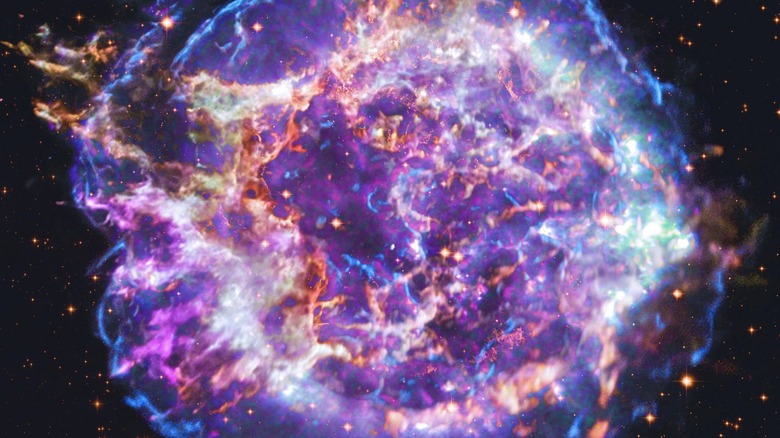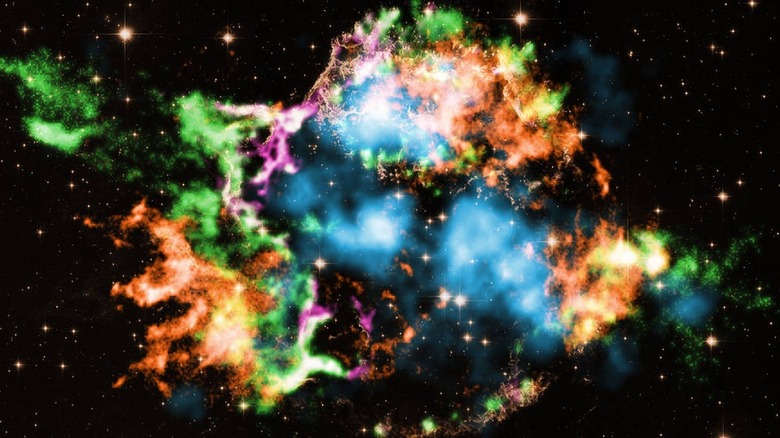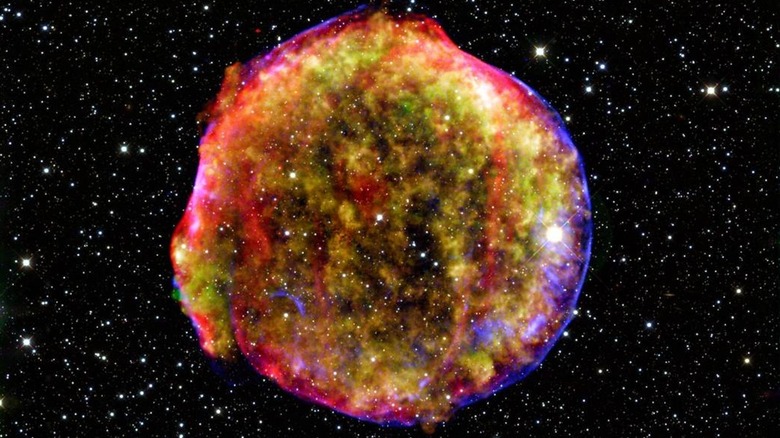This Is What Happens When A Star Goes Supernova
A supernova is not just any cosmic explosion, but rather is distinguished as the largest explosion that happens in space. As NASA explains, the blast of a supernova can be so violent that it creates a black hole. Some supernovae can be seen without a telescope. In A.D. 185, astronomers in ancient China registered a "star guest" in the night sky which lasted eight months, the space agency reported in 2012. RCW 86 is known today as the oldest record of a supernova. Remnants of the explosion can still be seen today with modern telescopes.
One of the most famous images captured by the Hubble Space Telescope is that of a supernova remnant found 6,500 light-years from Earth: the Crab Nebula. Space.com explains that in the year 1054, the life of this star, originally 10 times the mass of our sun, ended with a bang. The event was seen throughout the entire world with registers made in Asia, as well as in the U.S., Arizona, and New Mexico where it was remembered through rock paintings.
Supernovae may seem like distant events that have no direct effect on our planet, but they have a vital role in the universe and life as we know it. According to the theory of the formation of the solar system, detailed by a 2017 study published in "Astrophysical Journal" (via Phys), 4.5 billion years ago our solar system began to form. A cloud of cosmic dust and gas collapsed after a nearby supernova exploded. The explosion sent shock waves across the collapsed cloud forcing it into a spin that attracted material. Eventually, the spin formed a high-pressurized core that gave birth to our sun.
What are the different types of supernovae?
Space.com explains that there are two types of supernovae. Type I supernovae explode in a nuclear reaction when a star, by accretion, accumulates cosmic matter from its region. Type II supernovae are the result of a star that collapses under its own gravity when it depletes its nuclear fuel.
But scientists have dug even deeper into the different types of supernovae. Astronomy explains that supernovae are divided into four different types: Type Ia, Type Ib, Type Ic, and Type II. Type Ia supernovae are linked to binary star systems that share an orbit. One of the stars, a white dwarf, pulls matter from a nearby star. Once the white dwarf accumulates a mass more than 1.4 times the mass of our sun, it collapses and explodes. These stars are rich in carbon and have little hydrogen.
Type Ib supernovae are massive dying stars that have 25 times the mass of our sun. They have little hydrogen and some helium. On the other hand, Type Ic supernovae are similar to Type Ibs but have lesser quantities of hydrogen and helium. Finally, Type II supernovae are stars rich in hydrogen and helium that collapse as their life ends. They have a mass eight times our sun. Type II supernova explosions are responsible for creating neutron stars and black holes.
Can our sun go supernova?
Physics publication CernCourrier reports that supernovae are very common. The study behind the news reveals that the rate of supernova explosions is one every 50 years — and that's just in our galaxy. The study based its conclusions on observations made by scientists using the European Space Agency's gamma-ray satellite INTEGRAL. The ESA satellite does not make visual contact with supernovae and instead measures the gamma-ray radiation they emit when the star of a core collapses.
For a star to go supernova, it needs to have a specific minimum mass. Our sun does not meet these mass requirements. In fact, as NASA explains, for our sun to explode as a supernova, it should have more than 20 times its actual mass. Therefore when our star dies off, it will not blast and create a black hole or a neutron star, though the sun's days are indeed numbered. It will run out of internal fuel and die off in about 6 billion years. Our sun will then transform into a white dwarf, and 1 billion years later, transform again into a red giant. The atmosphere of the sun will expand, ultimately engulfing our planet and part of our solar system while ending all life on Earth. One billion years later, the sun will collapse and become a white dwarf.


